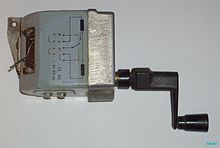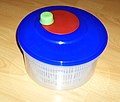Hand crank
The crank as a control element is called a hand crank or lyre .
Basic principle
The basic principle of a hand crank corresponds to that of a one-armed lever in mechanics , whereby the lever arm corresponds to the distance between the handle of the crank and the bearing pivot point in the center of the crank. The torque generated by the hand crank is the force multiplied by the length of the crank .
Functions
The turn of the crank can be converted into a rotary movement (drum, gear), a longitudinal movement (rope, push rod, spindle) or a tilting movement.
Rotary motion

Old telephone with hand crank for the crank inductor
- a hand drill , grindstone, or other hand tools or machines
- from historical calculating machines or other office machines
- of historic coffee grinders
- a historical film camera or film projector
- a meat grinder , a salad spinner, a liquor or other kitchen tools
- of a sharpener
- a centrifuge
- for winding with a winch , reel ( cable drum , fishing reel or kite line reel )
- of a hand crank planetarium after Wilhelm Schickard
- the barrel of a barrel organ , hurdy-gurdy or other musical instrument
- a barrier
- Starting a historic internal combustion engine
- a roller shutter or an awning
- a bulk material pusher
Pulling or pushing
- the slide of a lathe , milling machine or other machine tools
- a winch on a sailboat or sailing ship
- an elevator system ( emergency operation )
- to open or close manually
Tilting movement
- a concrete mixer
- a Bessemer pear
- a butterfly valve or other valve z. B. in a wind tunnel
Applications
Related topics
- In railroad draisines , a crank is driven by a hand-operated crank arm .
- The counterpart in foot operation is the crank .






